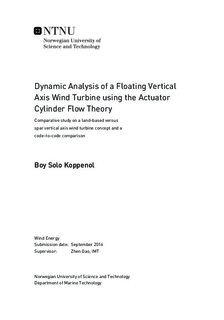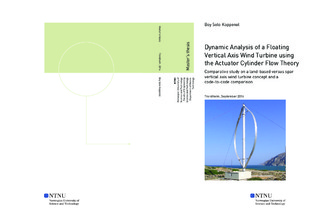| dc.description.abstract | An ever-increasing demand for electricity pushes the wind energy industry to deep waters that favor floating concepts. Vertical axis wind turbines (VAWTs) failed for onshore applications in the 1980s, but its advantages raise the potential for competitive floating designs and ultimately lowering the cost of energy. This thesis aims to (1) better understand the dynamic response characteristics of such floating concept and (2) critically evaluate numerical tools able to perform fully coupled dynamic analysis on floating VAWTs.
The studied wind energy converter is a combination of DeepWind s two-bladed Darrieus rotor and the OC3 spar floater. A comparative study is made between this spar concept and the equivalent land-based VAWT in both steady and unsteady wind-wave environments. The dynamic responses are calculated by the aero-hydro-servo-elastic code SIMO-RIFLEX-AC, designed to model physical phenomena as accurately and efficiently as possible. Efficiency-driven design solutions imply simplifications in the field of aerodynamic, hydrodynamic and structural modeling. The effect of modeling theories on the calculated dynamic response of the spar VAWT is studied in a code-to-code comparison between HAWC2 and SIMO-RIFLEX-AC. Special attention is devoted to the aerodynamic models, which are both based on the Actuator Cylinder (AC) flow theory.
The model-comparison shows high energy content at the 2P frequency in most responses, this characterizes the two-bladed Darrieus rotor. Aerodynamic loads excite the first tower modes (close to 2P) of the land-based VAWT, whereas the spar VAWT hints to a tower mode around the 4P frequency. Tower tilt of the spar concept pitch offset extends up to induces gravitational loads at the tower base and blades, and also reduce the generated power up to 5%. Dynamic content from hydrodynamic loads is strongly felt at the tower base, but the effect of wind turbulence is more significant in terms of platform motions and rotor speed. Introducing wind turbulence reduces the aerodynamic and structural loads.
The code-to-code comparison shows that HAWC2 s aerodynamic model calculates lower loads in steady wind, but higher aerodynamic torque in turbulent wind. Dynamic stall significantly increases the lift force in the downwind half of the rotor, causing an overall increase of aerodynamic load at low tip-speed ratios. The wave-induced platform response is stronger in HAWC2, which is also felt at the tower base. The physical mooring system in SIMO-RIFLEX-AC endures an increased mean tension, but its standard deviation is lower. | |

